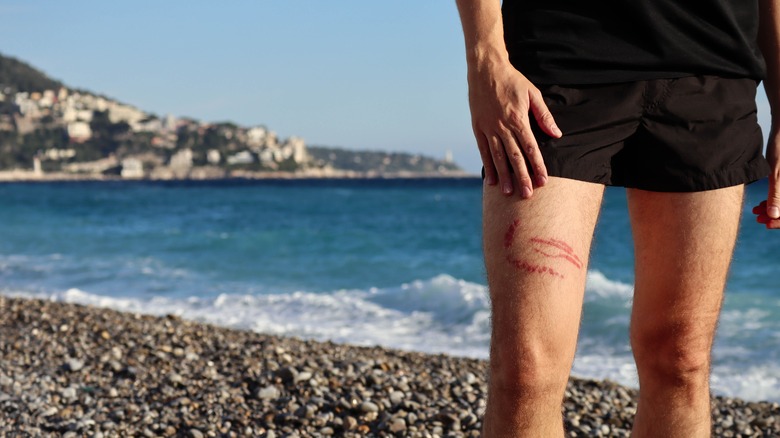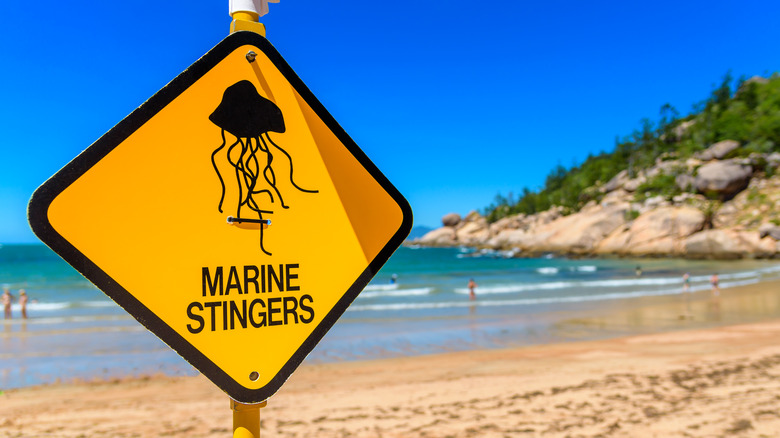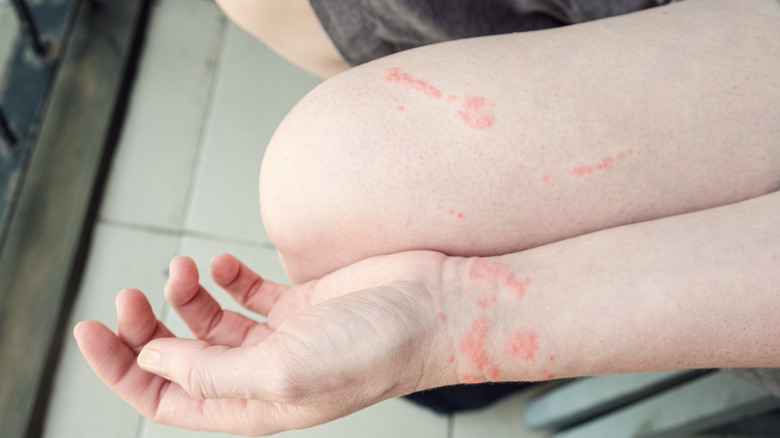Why You Should Never Pee On A Jellyfish Sting (And What To Do Instead)
Sitting on the beach looking down at the wavy, red tentacle lines of a fresh jellyfish sting seared into your aching leg, you may be tempted to do whatever you can to fix the pain. While the popular myth states that you should have somebody pee on the sting, that is absolutely not a good idea. You'll want to get the stinging cells out of the wound as soon as possible, and rinsing it out with seawater can help, but human urine is not the right tool for the job.
You should always attempt to completely avoid jellyfish on your vacation by staying out of the ocean when experts predict a lot of jellyfish activity, but the ocean is not exactly predictable. You might have taken every precaution to snorkel safely around a coral reef and still find yourself nose to bell with a Hawaiian box jelly. If it happens, don't panic — and definitely don't pee.
Pee makes it hurt more
"Jellyfish stings are painful enough without amplifying the symptoms," emergency medical practitioner Dr. Thomas Waters told the Cleveland Clinic. "You might mean well by peeing on a sting, but putting the wrong substance on it can really make things worse."
The reason for this has to do with how jellyfish sting. They have stinging cells all over their tentacles that cause severe pain and blistering when touched. Many of those stinging cells stay stuck to the wound, and any wrong move can activate them again, causing them to pump more venom into their victim. Many people try to fix the issue by pouring drinking water over it, but unfortunately, the change in salinity triggers the cells to release more venom.
But what about pee? The idea that peeing on a jellyfish sting relieves the pain is an old myth, popularized by the '90s sitcom "Friends." Urine is almost entirely water, especially for a well-hydrated person, so peeing on jellyfish stinging cells can make them release more venom just like pouring fresh water on them would. There are much better ways to rinse out a wound — like using the ocean you presumably just crawled out of.
What actually helps a jellyfish sting
You might be having the time of your life swimming and snorkeling in Hawaii, only to have an excruciatingly painful experience ruin your afternoon on the beach. If you're confused, throwing up, having trouble breathing, or having other serious symptoms, someone needs to call emergency services right away.
If all you're feeling is horrible pain around the sting, there are some scientifically backed solutions, and fortunately, none of them involve being peed on. No matter what, the most important thing you can do is to stay calm. Not only does this help you make good decisions, but it also prevents the venom from flooding through your system.
A meta-analysis from Marine Drugs, which analyzed various studies on the efficacy of different treatments for jellyfish stings, recommends thoroughly rinsing the area where you were stung with seawater to remove any remaining stinging cells, and if there are any tentacles stuck to you, getting them off right away. Just be careful not to use your bare hands as they will be stung, too. If readily available, you could mix baking soda and seawater together and apply the mixture to the area for a few minutes, or soak your skin in hot water (107 to 113 degrees Fahrenheit ) to relieve the pain. Afterward, you can take standard painkillers to help dull the stinging.


